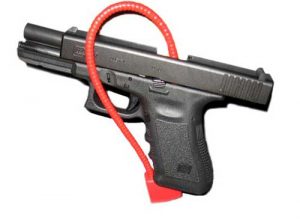 |
More than half of gun owners do not safely store all their guns, according to a new survey of 1,444 U.S. gun owners conducted by researchers at the Johns Hopkins Bloomberg School of Public Health.
The survey, believed to be the first nationally representative sample in 15 years to examine gun storage practices in U.S. households, found that 54 percent of gun owners reported not storing all their guns safely. The internet-based survey was fielded by the survey research firm GfK Knowledge Networks between March 15 and April 13, 2016.
The survey defined safe storage as all guns stored in a locked gun safe, cabinet or case, locked into a gun rack or stored with a trigger lock or other lock. This definition is based on research showing these practices reduce the risk of unauthorized access or use.
The findings were published Feb. 22 in the American Journal of Public Health.
“Household gun ownership can increase the risk of homicides, suicides, and unintentional shootings in the home, but practicing safe storage for all guns reduces these risks,” says lead study author Cassandra Crifasi, PhD, MPH, an assistant professor with the Johns Hopkins Center for Gun Policy and Research. “The survey findings indicate a real public health emergency. More than half of gun owners in the U.S. are not storing all of their guns safely—in a locked gun safe, cabinet or case, locked into a gun rack, or secured with a trigger lock.”
The survey also found that children under the age of 18 were present in approximately one-third, or 34 percent, of the homes. Gun owners were 44 percent more likely to report safely storing all their firearms if they have a child under the age of 18 in the home: Slightly more than half, or 55 percent, of gun owners with children under 18 reported storing all of their guns safely.
Respondents were also asked about factors that influenced their gun storage practices. Concerns about home defense was selected by 43 percent, a gun safety training course by 35 percent, and family discussions by 30 percent.
In 2016, the most recent year of complete data, there were 1,637 firearm deaths among children under the age of 18; 39 percent of these deaths were the result of suicide. States with child access prevention laws that require gun owners to ensure children do not gain unauthorized access to their firearms report fewer firearm suicides among adolescents. Studies have also shown a decreased risk for self-inflicted injury among adolescents when guns are stored safely.
This new research finds that gun owners who reported a gun safety training course influenced their gun storage practices were twice as likely to practice safe storage for all their guns, and gun owners who cited discussions with family members as influencing their decisions were 39 percent more likely to practice safe storage.
“It’s encouraging to see the positive associations between safety training and reporting safe storage practices,” said study co-author Daniel Webster, ScD, MPH, director of the Johns Hopkins Center for Gun Policy and Research. “Requiring gun purchasers to take safety training classes, as a handful of states already do, might lead to more gun owners storing their guns safely.”
The survey also found that gun owners who reported that their storage decisions were influenced by concerns about home defense were 30 percent less likely to practice safe storage for all their firearms.
“Many bring guns into their homes for self-defense, but unsecured guns can lead to unintentional shootings, suicides, and tragic cases of troubled teens using guns to commit acts of violence,” said Crifasi. “Communicating with gun owners about the importance of safe storage is a challenging opportunity. If we are successful at improving storage practices among gun owners, particularly those with children in the home, we could reduce risks for gun violence and injury.”
The survey also asked gun owners which groups could best communicate information about safe storage practices: 77 percent of respondents selected law enforcement as good messengers to teach gun owners about safe storage, followed by hunting/outdoor organizations (73 percent), active duty military (73 percent), military veterans (72 percent), and the NRA (71 percent). Physicians and celebrities scored lowest (19 percent and 11 percent, respectively).
“Storage Practices of U.S. Gun Owners” was written by Cassandra Crifasi, PhD, MPH, Mitchell L. Doucette, MPH, Emma E. McGinty, PhD, MPH, Daniel Webster, ScD, MPH, and Colleen Barry, PhD, MPH.
Funding for the research came from grants to the Johns Hopkins Center for Gun Policy and Research from the Simmons Foundation.
Source:Johns Hopkins

